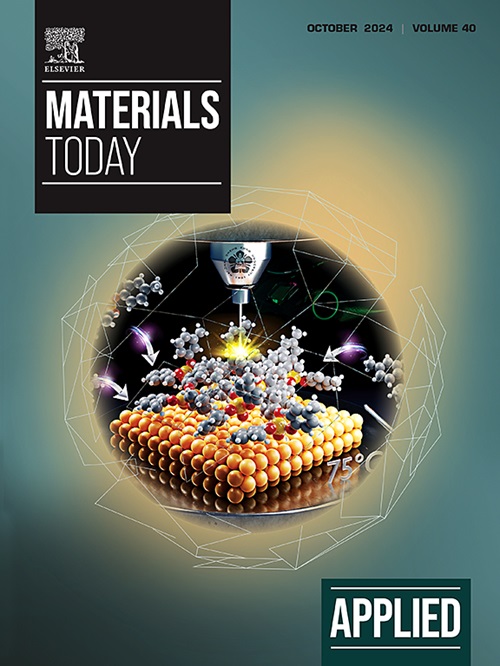基于界面工程铁电挥发性记忆晶体管的人工痛觉感受器
IF 6.9
2区 材料科学
Q1 MATERIALS SCIENCE, MULTIDISCIPLINARY
引用次数: 0
摘要
忆阻器可模拟生物突触和神经元,其驱动的神经形态计算领域的最新进展推动了创新信息技术的发展。要将忆阻器的应用扩展到人工神经系统,电子受体对于将外部刺激转化为内部神经系统的信号至关重要。将神经元器件集成到神经形态计算中的关键要求包括实现阈值行为、最大限度地降低功耗以及确保与互补金属氧化物半导体(CMOS)技术的兼容性。铪基铁电忆阻器以其在纳米尺度上的稳健铁电特性和与 CMOS 技术的兼容性而著称。然而,它们的非易失性电阻开关历来限制了它们在需要阈值开关的神经元传感应用中的适用性。本研究通过在 TiN/HfZrO(HZO)/TiO/TiN 异质结构中加入纳米级 TiO 界面层作为储氧层,展示了阈值开关行为。该层有助于在铁电 HZO 层中形成氧空位,作为内部电荷阱点。因此,铪基铁电记忆晶体管具有挥发性开关特性,使其能够通过内部电荷捕获和分离机制发挥痛觉器件的功能。这些挥发性忆阻器适用于需要对外部刺激做出阈值检测、松弛、异动感和超痛感等反应的人工痛觉感受器系统。这种能力为开发先进的仿人机器人开辟了道路,使其能够在具有挑战性的环境(如外太空或危险条件)中快速适应和响应,利用实时感官处理实现有效操作和生存。本文章由计算机程序翻译,如有差异,请以英文原文为准。
Artificial nociceptor based on interface engineered ferroelectric volatile memristor
Recent advancements in neuromorphic computing driven by memristors, which emulate biological synapses and neurons, have spurred the development of innovative information technologies. To extend memristor applications to artificial nervous systems, electronic receptors are crucial for converting external stimuli into signals for the internal nervous system. Key requirements for integrating neuron devices into neuromorphic computing include achieving threshold behavior, minimizing power consumption, and ensuring compatibility with complementary metal-oxide semiconductor (CMOS) technology. Hafnium-based ferroelectric memristors are known for their robust ferroelectric properties at nanoscales and compatibility with CMOS technology. However, their non-volatile resistive switching has historically limited their suitability for neuron sensory applications requiring threshold switching. This study demonstrates threshold switching behavior in a TiN/HfZrO(HZO)/TiO/TiN heterostructure by incorporating a nanoscale TiO interfacial layer as an oxygen reservoir. This layer facilitates the formation of oxygen vacancies within the ferroelectric HZO layer, serving as internal charge trap sites. As a result, hafnium-based ferroelectric memristors exhibit volatile switching characteristics, enabling them to function as nociceptive devices through internal charge trapping and detrapping mechanisms. These volatile memristors are suitable for artificial nociceptor systems requiring responses such as threshold detection, relaxation, allodynia, and hyperalgesia to external stimuli. This capability opens avenues for developing advanced humanoid robots capable of rapid adaptation and response in challenging environments such as outer space or hazardous conditions, leveraging real-time sensory processing for effective operation and survival.
求助全文
通过发布文献求助,成功后即可免费获取论文全文。
去求助
来源期刊

Applied Materials Today
Materials Science-General Materials Science
CiteScore
14.90
自引率
3.60%
发文量
393
审稿时长
26 days
期刊介绍:
Journal Name: Applied Materials Today
Focus:
Multi-disciplinary, rapid-publication journal
Focused on cutting-edge applications of novel materials
Overview:
New materials discoveries have led to exciting fundamental breakthroughs.
Materials research is now moving towards the translation of these scientific properties and principles.
 求助内容:
求助内容: 应助结果提醒方式:
应助结果提醒方式:


